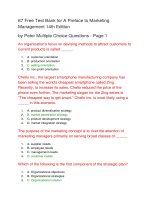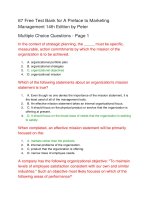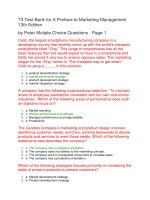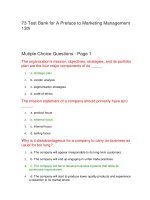Test bank of fred r david – strategic management, 13th edition ch09
Bạn đang xem bản rút gọn của tài liệu. Xem và tải ngay bản đầy đủ của tài liệu tại đây (97.44 KB, 33 trang )
Exam
Name___________________________________
TRUE/FALSE. Write 'T' if the statement is true and 'F' if the statement is false.
1)
Less than 2 percent of formulated strategies are successfully implemented.
1)
_______
2)
Given that most information on individuals is available online, the extent to which companies can track
individuals' movements on the Internet is not a marketing issue of great concern to consumers today.
2)
_______
3)
Market penetration can be defined as the subdividing of a market into distinct subsets of customers
according to needs and buying habits.
3)
_______
4)
The marketing mix component factors are product, place, promotion, price and people.
4)
_______
5)
With market segmentation, a firm can better operate with limited resources.
5)
_______
6)
The most common bases for segmenting markets are geographic and demographic.
6)
_______
7)
Segmentation often reveals that large, random fluctuations in demand actually consist of several small,
predictable, and manageable patterns.
7)
_______
8)
Segmenting industrial markets is generally simpler and easier than segmenting consumer markets.
8)
_______
9)
Generally, market segmentation is followed by a market diversification strategy.
9)
_______
10)
After segmenting markets so that a firm can target particular customer groups, the next step is to find out
what customer groups want and expect.
10)
______
11)
In general, the Internet makes market segmentation easier.
11)
______
12)
Multidimensional scaling involves examining three or more criteria simultaneously in a product-positioning
analysis.
12)
______
13)
A firm can usually serve two or more market segments with the same strategy.
13)
______
14)
It is acceptable for firms to create expectations that exceed the service that can or will be offered, if it will
attract customers.
14)
______
15)
Return on assets is the most widely used technique for determining whether debt, stock, or a combination
of debt and stock is the best alternative for raising capital to implement strategies.
15)
______
16)
Besides net profit from operations and the sale of assets, the two basic sources of funds for an ongoing
enterprise are debt and equity.
16)
______
17)
In low earning periods, too much debt in the capital structure of an organization can endanger
stockholders' returns and jeopardize company survival.
17)
______
18)
Additional capital is often required for successful strategy implementation.
18)
______
19)
An EPS/EBIT chart can be constructed to determine the breakeven point, where one financing alternative
becomes more attractive than another.
19)
______
20)
A reason for concern over the dilution of company stock is a possible hostile takeover.
20)
______
21)
When additional debt is issued to finance implementation of strategy, both ownership and control of the
enterprise are diluted.
21)
______
22)
In times of depressed stock prices, stock issuances often prove to be the most suitable alternative for
obtaining capital.
22)
______
23)
A projected financial analysis can be used to forecast the impact of various implementation decisions.
23)
______
24)
When performing pro forma financial analyses, the balance sheet should be prepared before the income
statement.
24)
______
25)
The percentage-of-sales method should be used for computing the cost of goods sold and additional
expense items in projected income statements.
25)
______
26)
The cash account is used as a plug figure in pro forma balance sheets.
26)
______
27)
The Sarbanes-Oxley Act of 2002 has eliminated the problem of firms inflating their financial projections, so
stakeholders need not worry about the financial projections of different companies.
27)
______
28)
A financial budget is a document that details how funds will be obtained and spent for a specified period of
time.
28)
______
29)
Limiting an organization's expenditures is the primary purpose of financial budgets.
29)
______
30)
The most common type of financial budget is the capital budget.
30)
______
31)
Although cash budgets can be a useful financial tool, publicly held companies are not required to complete
them.
31)
______
32)
A limitation of financial budgets is that they can hide inefficiencies, if they are based solely on precedent
rather than on periodic evaluation of circumstances and standards.
32)
______
33)
All the methods for determining a business' worth can be grouped into three basic approaches what a firm
owns, what a firm earns, and what a firm spends.
33)
______
34)
A conservative rule of thumb for estimating a business' worth is that it is 10 times the firm's most current
annual profit.
34)
______
35)
A recommended approach for determining a firm's worth is to base the analysis on the selling price of a
similar company.
35)
______
36)
To determine the price-earnings ratio, divide the market price of the firm's annual earnings per share by
the common stock, and multiply this number by the firm's average net income for the past 10 years.
36)
______
37)
Goodwill is the estimated values associated with a name brand.
37)
______
38)
The costs of paying lawyers, accountants, and underwriters when engaging in initial public offerings (IPO) is
substatially higher in the Arab world than in the Western world.
38)
______
39)
It is generally not recommended for companies with less than $10 million in sales to go public.
39)
______
40)
In general, there are very little costs associated with going public.
40)
______
41)
Buying off the outstanding shares of your company from the open market to make the company private is
what going public means.
41)
______
42)
If the rate of market growth and technical progress is fast and there are few barriers to possible new
entrants, then in-house R&D is the preferred solution.
42)
______
43)
According to research, the most successful organizations use a research and development strategy that
ties internal strengths to external opportunities and is linked with corporate objectives.
43)
______
44)
R&D policies can enhance strategy implementation efforts to emphasize product or process improvements.
44)
______
45)
A major effort in R&D may be very risky if technology is changing rapidly and the market is growing slowly.
45)
______
46)
One R&D strategy is to be an innovative imitator of successful products.
46)
______
47)
A current trend in R&D management involves the lifting of the veil of secrecy whereby firms, even major
competitors, are joining forces to develop new products.
47)
______
48)
The process of strategic management is facilitated immensely in firms that have an effective information
system.
48)
______
49)
Increased costs are a disadvantage of a good information system.
49)
______
50)
With information technology, in some cases it is possible to do away with the workplace by allowing
employees to work at home or anywhere, anytime.
50)
______
MULTIPLE CHOICE. Choose the one alternative that best completes the statement or answers
the question.
51)
What percent of strategies formulated are successfully implemented?
51)
______
A)
More than 80 percent
B)
Less than 10 percent
C)
Approximately 66 percent
D)
About 30 percent
E)
Between 40 to 60 percent
52)
What level of management is directly affected by strategy implementation?
52)
______
A)
Sales managers
B)
Project managers
C)
Division managers
D)
Plant managers
E)
all of these
53)
All of the following are examples of marketing decisions that require policies except
53)
______
A)
to use heavy, light, or no TV advertising.
B)
to advertise online or not.
C)
to offer a complete or limited warranty.
D)
to use exclusive dealerships or multiple channels of distribution.
E)
to be a market leader or follower.
54)
Which two variables are of central importance to strategy implementation?
54)
______
A)
Competition and collaboration.
B)
Product development and market development.
C)
Marketing penetration and competition.
D)
Diversification and budgeting.
E)
Market segmentation and product positioning.
55)
Subdividing a market into distinct subsets of customers according to their needs and the way they buy and
use a product or service is
55)
______
A)
positioning.
B)
market segregation.
C)
market segmentation.
D)
product diversification.
E)
market penetration.
56)
Why is market segmentation an important variable in strategy implementation?
56)
______
A)
Mass production, mass distribution and mass advertising are not always required.
B)
All company strategies require increased sales through new markets and products.
C)
It allows a firm to operate with limited resources.
D)
Market segmentation decisions directly affect marketing mix variables.
E)
all of the above
57)
Which of the following variables are not directly affected by market segmentation?
57)
______
A)
Promotion
B)
Process
C)
Product
D)
Price
E)
Place
58)
Why is market segmentation an important variable in the strategy-implementation process?
58)
______
A)
It directly affects marketing mix variables.
B)
It allows a firm to minimize per-unit profits and per-segment sales.
C)
It allows a firm to operate with no resources.
D)
Company strategies do not require increased sales through new markets and products.
E)
all of the above
59)
Perhaps the most dramatic new market segmentation strategy is the
59)
______
A)
treatment of industrial markets.
B)
focusing on universal products.
C)
targeting of regional tastes.
D)
preference for international over domestic sales.
E)
none of these
60)
Matching of which factors would allow factories to produce desirable levels without extra shifts, overtime
or subcontracting?
60)
______
A)
Markets and competitors
B)
Competition and positioning
C)
Segments and demand
D)
Customer behavior and positioning
E)
Supply and demand
61)
Which variable would be considered part of the product element of the marketing mix?
61)
______
A)
Advertising
B)
Inventory levels and location
C)
Publicity
D)
Packaging
E)
Payment terms
62)
Which variable would be considered part of the place element of the marketing mix?
62)
______
A)
Product line
B)
Sales territory
C)
Service level
D)
Personal selling
E)
Discounts and allowances
63)
What entails developing schematic representations that reflect how products or services compare to
competitors', on the dimensions that are most important to success in the industry?
63)
______
A)
Segmentation
B)
Positioning
C)
Penetration
D)
Budgeting
E)
Diversification
64)
Looking for a vacant niche helps a company determine
64)
______
A)
its projected R & D expenditures.
B)
its advertising budget.
C)
the size of the marketing department.
D)
the best place to position a product.
E)
the best place to locate a new facility.
65)
Multidimensional scaling is used to determine
65)
______
A)
the size of a new department.
B)
product positioning.
C)
the size of a new building.
D)
market segmentation.
E)
the amount of high-tech equipment a firm needs.
66)
Which of the following is (are) true about two different market segments?
66)
______
A)
They usually require different marketing strategies.
B)
They can usually be served with the same marketing strategy.
C)
They are most effective when a firm squats between two segments.
D)
They are usually incompatible.
E)
They are always in different geographic locations.
67)
Which of the following is not an example of a decision that may require finance/accounting policies?
67)
______
A)
To determine the amount of product diversification
B)
To extend the time of accounts receivable
C)
To establish a certain percentage discount on accounts within a specified period of time
D)
To lease or buy fixed assets
E)
To use LIFO, FIFO, or a market-value accounting approach
68)
In the low earnings period, too much ________ in the capital structure of an organization can endanger
stockholders' return and jeopardize company survival.
68)
______
A)
equity
B)
debt
tax
C)
D)
liquid assets
E)
cash
69)
Which of these obligations generally must be met, regardless of circumstances?
69)
______
A)
Equity
B)
Employee
C)
Fixed debt
D)
Dividends
E)
all of these
70)
What is the most widely used technique for determining the best combination of debt and stock?
70)
______
A)
Gross profit analysis
B)
Debt-to-stock ratio
C)
Present value analysis
D)
Capital asset pricing model
E)
Earnings Per Share/Earnings Before Interest and Taxes analysis
71)
After completing an EPS/EBIT analysis, what conclusions would you make if the debt line is above the stock
line throughout the range of EBIT on the graph?
71)
______
A)
The company should be privately owned.
B)
Dividends must be considered before conclusions can be made.
C)
Stock would be the best financing alternative.
D)
A combination of debt and stock is probably the best financial alternative.
E)
Debt appears to be the best financing alternative.
72)
What becomes a more attractive financing technique when cost of capital is high?
72)
______
A)
Borrowing
B)
Debt
C)
Cost cutting
D)
Stock issuance
E)
Staying privately owned
73)
What is a drawback of using only equity to raise capital?
73)
______
A)
That it doesn't raise as much capital as debt financing
B)
Fluctuations in the stock market
C)
Dilution of the control of the company
D)
That it will cause EPS to roller-coaster
E)
The cost
74)
A benefit of using projected balance sheets and income statements is that
74)
______
A)
all of the above
B)
insurance needs can be computed.
C)
it is useful in analyzing past performance.
D)
an organization can compute projected financial ratios under various scenarios.
E)
money can be put aside to pay future income taxes.
75)
P r o j e c t e d fi n a n c i a l a n a l y s i s i s a n i m p o r t a n t s t r a t e g y -implementation technique
because
75)
______
A)
it is an exact measurement of financial costs in the future.
B)
insurance needs can be computed.
C)
it is an exact measurement of future company profits.
D)
it allows an organization to examine the expected results of various actions and approaches.
E)
none of the above
76)
What is a central strategy-implementation technique that allows an organization to examine the expected
results of various actions and approaches?
76)
______
A)
EPS/EBIT
B)
Financial budgeting
C)
TOWS analysis
D)
External analysis
E)
Projected financial statement analysis
77)
The first step in preparing a projected statement is to
77)
______
A)
prepare the projected balance sheet.
B)
calculate the projected net income.
C)
take an inventory of goods.
D)
prepare the projected income statement.
E)
estimate increases in debt.
78)
In preparing projected statements, which of these methods is recommended to project cost of goods sold
and the expense items in the income statement?
78)
______
A)
Outstanding shares method
B)
Price-earnings ratio met
C)
Determining the net worth method
D)
Percentage-of-sales method
E)
What a firm earns method
79)
Which element in the projected income statement cannot be forecasted using the percentage-of-sales
method?
79)
______
A)
Administrative expense
B)
Interest expense
C)
Cost of goods sold
D)
Selling expense
E)
All of these items are forecasted using the percentage-of-sales method.
80)
Retained earnings is obtained by subtracting
80)
______
A)
interest expense from EBT.
B)
taxes from EBIT.
C)
any dividends from net income.
D)
net income from EBIT.
E)
EBIT from CGS.
81)
In projected financial statements, what account is used as a plug figure?
81)
______
A)
Cash
B)
Stockholders' equity
C)
Retained earnings
D)
Fixed assets
E)
Long-term liabilities
82)
Which of these is the most common type of budgeting time frame?
82)
______
A)
Daily
B)
Annual
C)
Every decade
D)
Quarterly
E)
Monthly
83)
If a firm incurs a loss during a particular year, or if the firm had positive net income but paid out dividends
more than the net income, its retained earnings for that year will most likely be
83)
______
A)
a large positive number.
B)
impossible to determine from this information.
C)
a negative number.
D)
zero.
E)
a low positive number.
84)
What is the most common type of financial budget?
84)
______
A)
Flexible
B)
Cash
C)
Sales
D)
Factory
E)
Profits
85)
Who has mandated that every publicly held company in the United States must issue an annual cash-flow
statement in addition to the usual financial reports?
85)
______
A)
FASB
B)
OPEC
C)
Congress
D)
SEC
E)
FCC
86)
How should financial budgets be thought of?
86)
______
A)
A tool for limiting expenditures.
B)
A method for obtaining the most productive and profitable use of an organization's resources.
C)
A method for rationing the profits from the past year.
D)
A tool for forecasting future profits.
E)
A method for determining who should receive the largest pay raise.
87)
What is a limitation of using financial budgets?
87)
______
A)
They are sometimes used as instruments of tyranny.
B)
They can become a substitute for objectives.
C)
They can hide inefficiencies if done only on precedent.
D)
They can be so detailed that they are cumbersome and expensive.
E)
all of the above
88)
Which of the following methods is not accepted for determining a business' worth?
88)
______
A)
What the firm's return on investment has been.
B)
What the firm will bring in the market.
C)
What the firm earns.
D)
What the firm owns.
E)
All of the above are accepted.
89)
Which of the following is/are not included in net worth?
89)
______
A)
Fixed assets
B)
Retained earnings
C)
Common stock
D)
Additional paid-in-capital
E)
All of these are included in net worth
90)
Which method of determining a firm's net worth divides the market price of the firm's stock by the annual
earnings per share, and multiplies the result by the firm's average net income for the past five years?
90)
______
A)
Current ratio method
B)
Long-term asset method
C)
Outstanding shares method
D)
Price-earnings ratio method
E)
Debt/equity method
91)
What best describes how much a company is worth?
91)
______
A)
It is static.
B)
It is the result of explicit accounting standards.
C)
An exact science.
D)
It is known only to the firm's accountants.
E)
An educated guess.
92)
The Financial Accounting Standard Board (FASB) Rule 142 deals with
92)
______
A)
improving marketing policies.
B)
hacking issues in MIS.
C)
goodwill.
D)
how firms conduct R & D.
E)
illegal inflation of financial projections.
93)
What is the best definition of goodwill?
93)
______
A)
Value associated with benefits from environmental programs
B)
Premiums paid for acquisition
C)
Excess of current assets over liabilities
D)
Value attached to the firm's reputation
E)
Excess of assets over liabilities
94)
If an initial stock issuance is at or under $1 million, what is the average total cost paid to lawyers,
accountants and underwriters?
94)
______
A)
5 percent
B)
10 percent
C)
5 percent
D)
25 percent
E)
40 percent
95)
R&D employees and managers perform all of the following tasks except
95)
______
A)
alternating products to particular tastes and specifications.
B)
researching resource availability.
C)
adapting processes to local markets.
D)
transferring complex technology.
E)
adjusting process to local raw materials.
96)
Which of the following is not a major approach to R&D?
96)
______
A)
To be a pioneer.
B)
To be an innovative imitator.
C)
To be a low-cost producer by mass-producing products similar to but less expensive than products recently
introduced.
D)
All of the above are major approaches to R&D.









